Publications
#journal

Abstract: The Internet of Things (IoT) is recognised as a game-changer technology that expands its applicability to a huge variety of domains. The key asset is the data that the myriad of sensors embedded in the environment are constantly generating. The paper describes a Blockchain-based IoT Data Marketplace (BIDM) and presents the proof-of-concept implementation that has been developed to validate it from a functional standpoint. The BIDM enables an ecosystem where sensor owners can expose the observations that their sensors generate while retaining control over who accesses each observation and directly getting revenues according to the price they have set.
DOI / Link: https://doi.org/10.1016/j.icte.2023.01.002
Sánchez, L., Lanza, J., González, I., Santana, J. R., Sotres, P.
ICT Express (2023)
#conference

Abstract: This paper focuses on the concept of data spaces, which can serve as a basis for the future data economy. In data spaces, applicable to various business domains, stakeholders will be able to share data with each other in a controlled way. First, the paper describes the real motivations and needs for enabling data spaces. Second, it highlights the major technical developments in the area of data spaces in the light of open ecosystems and standards. Lastly, it focuses on two key challenges for enabling data spaces: 1) Data interoperability, 2) Data value generation. As a concrete data spaces solution example, this paper proposes the “Green Twin” use case that can be developed as a carbon neutrality solution in the domains of mobility and smart cities.
DOI / Link: https://doi.org/10.1145/3565011.3569058
Solmaz, G., Cirillo, F., Fürst, J., Jacobs, T., Bauer, M., Kovacs, E., Santana, J. R., Sánchez, L.
DE ’22: Proceedings of the 1st International Workshop on Data Economy
#conference
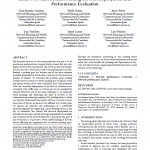
Abstract: The dramatic increase of the urban population has put a lot of pressure in modern urban transportation systems. This not only implies noteworthy air pollution, and waste in time and energy, but also has led to the critical issue of the parking spots scarcity. Finding a parking spot has become one of the most common problems mentioned by drivers due to the day-by-day increase in number of vehicles. To overcome this problem, smart parking services based on sensors to detect parking spot occupancy status and inform drivers about their availability have been proposed. With the successful deployment of this kind of solutions, costs associated with traffic jams or wasted gas can be considerably reduced. However, one of the main challenges to be addressed when planning and deploying this kind of services is the communication technology employed by parking sensors, which are typically buried under the asphalt, and has to be able to cover large areas of the city in the most cost-efficient way. In this paper, we analyze the behavior and performance of a LoRaWAN network employed for supporting a Smart Parking service in the city of Santander. The sensors and network deployment are described in the paper and the thorough experimental assessment and evaluation of the network behavior is presented. The goal of this evaluation is to provide a better understanding of the key factors affecting the communication of outdoor parking spots.
DOI / Link: https://doi.org/10.1145/3551663.3558685
Santana, J. R., Sotres, P., Pérez, J., Sánchez, L., Lanza, J., Muñoz, L.
ACM International Symposium on Performance Evaluation of Wireless Ad Hoc, Sensor, and Ubiquitous Networks 2022 (PE-WASUN 2022)
#conference
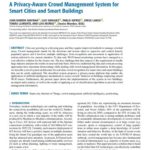
Abstract: El despliegue de infraestructuras de la Internet de las Cosas ha supuesto una revolución en la adquisición de información del contexto alrededor de los servicios provistos para y por los usuarios. Sin embargo, las soluciones globales más comunes se basan en metodologías propietarias que no implementan mecanismos que acrediten y garanticen el origen y futuro uso confiable de los datos generados y compartidos. Estas, además, excluyen al usuario como fuente de los datos de contexto de la cadena de valor. Este artículo describe y evalúa un ecosistema de gestión de datos IoT basado en Blockchain, que garantiza al proveedor el control sobre quién, cómo y cuándo hace uso de los datos, al tiempo que permite explotar nuevos modelos de negocio y monetización de los mismos.
DOI / Link: https://jitel21.udc.es/files/actasJITEL21.pdf
Lanza, J., González, Iván., Sánchez, L., Santana, J. R., Sotres, P.
XV Jornadas de Ingeniería Telemática (JITEL 2021)
#journal

Abstract: Cities are growing at a dizzying pace and they require improved methods to manage crowded areas. Crowd management stands for the decisions and actions taken to supervise and control densely populated spaces and it involves multiple challenges, from recognition and assessment to application of actions tailored to the current situation. To that end, Wi-Fi-based monitoring systems have emerged as a cost-effective solution for the former one. The key challenge that they impose is the requirement to handle large datasets and provide results in near real-time basis. However, traditional big data and event processing approaches have important shortcomings while dealing with crowd management information. In this paper, we describe a novel system architecture for real-time crowd recognition for smart cities and smart buildings that can be easily replicated. The described system proposes a privacy-aware platform that enables the application of artificial intelligence mechanisms to assess crowds’ behavior in buildings employing sensed Wi-Fi traces. Furthermore, the present paper shows the implementation of the system in two buildings, an airport and a market, as well as the results of applying a set of classification algorithms to provide crowd management information.
DOI / Link: https://doi.org/10.1109/ACCESS.2020.3010609
Santana, J. R., Sánchez, L., Sotres, P., Lanza, J., Llorente, T. & Muñoz, L.
IEEE Access 8 (2020): 135394-135405.
#journal
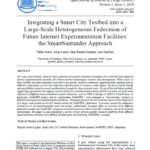
Abstract: For some years already, there has been a plethora of research initiatives throughout the world that have deployed diverse experimentation facilities for Future Internet technologies research and development. While access to these testbeds has been sometimes restricted to the specific research community supporting them, opening them to different communities can not only help those infrastructures to achieve a wider impact, but also to better identify new possibilities based on novel considerations brought by those external users. On top of the individual testbeds, supporting experiments that employs several of them in a combined and seamless fashion has been one of the main objectives of different transcontinental research initiatives, such as FIRE in Europe or GENI in United States. In particular, Fed4FIRE project and its continuation, Fed4FIRE+, have emerged as “best-in-town” projects to federate heterogeneous experimentation platforms. This paper presents the most relevant aspects of the integration of a large scale testbed on the IoT domain within the Fed4FIRE+ federation. It revolves around the adaptation carried out on the SmartSantander smart city testbed. Additionally, the paper offers an overview of the different federation models that Fed4FIRE+ proposes to testbed owners in order to provide a complete view of the involved technologies. The paper is also presenting a survey of how several specific research platforms from different experimentation domains have fulfilled the federation task following Fed4FIRE+ concepts.
DOI / Link: https://www.ronpub.com/ojiot/OJIOT_2019v5i1n10_Sotres.html
Sotres, P., Lanza, J., Santana, J. R. & Sánchez, L.
Open Journal of Internet of Things, 2019, 5(1), 117-132
#journal

Abstract: Understanding crowd mobility behaviors would be a key enabler for crowd management in smart cities, benefiting various sectors such as public safety, tourism and transportation. This article discusses the existing challenges and the recent advances to overcome them and allow sharing information across stakeholders of crowd management through Internet of Things (IoT) technologies. The article proposes the usage of the new federated interoperable semantic IoT platform (FIESTA-IoT), which is considered as “a system of systems.” The platform can support various IoT applications for crowd management in smart cities. In particular, the article discusses two integrated IoT systems for crowd mobility: the Crowd Mobility Analytics System and the Crowd Counting and Location System (from the SmartSantander testbed). Pilot studies are conducted in the Gold Coast, Australia, and Santander, Spain, to fulfill various requirements such as providing online and offline crowd mobility analyses with various sensors in different regions. The analyses provided by these systems are shared across applications in order to provide insights and support crowd management in smart city environments.
DOI / Link: https://doi.org/10.1109/MCOM.2019.1800611
Solmaz, G., Wu, F. J., Cirillo, F., Kovacs, E., Santana, J. R., Sanchez, L., Sotres,P. & Muñoz, L.
IEEE Communications Magazine, 57(4), 40-46.
#journal
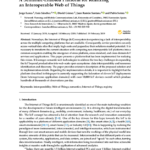
Abstract: Nowadays, the Internet of Things (IoT) ecosystem is experiencing a lack of interoperability across the multiple competing platforms that are available. Consequently, service providers can only access vertical data silos that imply high costs and jeopardize their solutions market potential. It is necessary to transform the current situation with competing non-interoperable IoT platforms into a common ecosystem enabling the emergence of cross-platform, cross-standard, and cross-domain IoT services and applications. This paper presents a platform that has been implemented for realizing this vision. It leverages semantic web technologies to address the two key challenges in expanding the IoT beyond product silos into web-scale open ecosystems: data interoperability and resources identification and discovery. The paper provides extensive description of the proposed solution and its implementation details. Regarding the implementation details, it is important to highlight that the platform described in this paper is currently supporting the federation of eleven IoT deployments (from heterogeneous application domains) with over 10,000 IoT devices overall which produce hundreds of thousands of observations per day.
DOI / Link: https://doi.org/10.3390/s18103375
Lanza, J., Sánchez, L., Santana, J. R., Gómez, D., & Sotres, P.
Sensors, 19(4), 869.
#journal
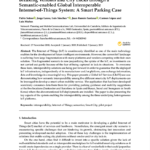
Abstract: The Internet of Things (IoT) is unanimously identified as one of the main technology enablers for the development of future intelligent environments. However, the current IoT landscape is suffering from large fragmentation with many platforms and vendors competing with their own solution. This fragmented scenario is now jeopardizing the uptake of the IoT, as investments are not carried out partly because of the fear of being captured in lock-in situations. To overcome these fears, interoperability solutions are being put forward in order to guarantee that the deployed IoT infrastructure, independently of its manufacturer and/or platform, can exchange information, data and knowledge in a meaningful way. This paper presents a Global IoT Services (GIoTS) use case demonstrating how semantic interoperability among five different smart city IoT deployments can be leveraged to develop a smart urban mobility service. The application that has been developed seamlessly consumes data from them for providing parking guidance and mobility suggestions at the five locations (Santander and Barcelona in Spain and Busan, Seoul and Seongnam in South Korea) where the abovementioned IoT deployments are installed. The paper is also presenting the key aspects of the system enabling the interoperability among the three underlying heterogeneous IoT platforms.
DOI / Link: https://doi.org/10.3390/s19020229
Sotres, P., Lanza, J., Sánchez, L., Santana, J. R., López, C., & Muñoz, L.
Sensors, 19(2), 229.
#journal

Abstract: The Internet of Things (IoT) concept has attracted a lot of attention from the research and innovation community for a number of years already. One of the key drivers for this hype towards the IoT is its applicability to a plethora of different application domains. However, infrastructures enabling experimental assessment of IoT solutions are scarce. Being able to test and assess the behavior and the performance of any piece of technology (i.e., protocol, algorithm, application, service, etc.) under real-world circumstances is of utmost importance to increase the acceptance and reduce the time to market of these innovative developments. This paper describes the federation of eleven IoT deployments from heterogeneous application domains (e.g., smart cities, maritime, smart building, crowd-sensing, smart grid, etc.) with over 10,000 IoT devices overall which produce hundreds of thousands of observations per day. The paper summarizes the resources that are made available through a cloud-based platform. The main contributions from this paper are twofold. In the one hand, the insightful summary of the federated data resources are relevant to the experimenters that might be seeking for an experimental infrastructure to assess their innovations. On the other hand, the identification of the challenges met during the testbed integration process, as well as the mitigation strategies that have been implemented to face them, are of interest for testbed providers that can be considering to join the federation.
DOI / Link: https://doi.org/10.3390/s18103375
Sánchez, L., Lanza, J., Santana, J., Agarwal, R., Raverdy, P., Elsaleh, T., Fathy, Y., Jeong, S., Dadoukis, A., Korakis, T., Keranidis, S., O’Brien, P., Horgan, J., Sacchetti, A., Mastandrea, G., Fragkiadakis, A., Charalampidis, P., Seydoux, N., Ecrepont, C. & Keranidis, S.
Sensors, 18(10), 3375.
#journal

Abstract: Infrastructures enabling experimental assessment of Internet of Things (IoT) solutions are scarce. Moreover, such infrastructures are typically bound to a specific application domain, thus, not facilitating the testing of solutions with a horizontal approach. This paper presents a platform that supports Experimentation as s Service (EaaS) over a federation of IoT testbeds. This platform brings two major advances. First, it leverages semantic web technologies to enable interoperability so that testbed agnostic access to the underlying facilities is allowed. Second, a set of tools ease both the experimentation workflow and the federation of other IoT deployments, independently of their domain of interest. Apart from the platform specification, this paper presents how this design has been actually instantiated into a cloud-based EaaS platform that has been used for supporting a wide variety of novel experiments targeting different research and innovation challenges. In this respect, this paper summarizes some of the experiences from these experiments and the key performance metrics that this instance of the platform has exhibited during the experimentation.
DOI / Link: https://doi.org/10.1109/ACCESS.2018.2867452
Lanza, J., Sánchez, L., Santana, J., Agarwal, R., Kefalakis, N., Grace, P., Elsaleh, T., Zhao, M., Tragos, E., Nguyen, H., Cirillo, F., Steinke, R. & Soldatos, J.
IEEE Access 6 (2018): 51607-51625.
#journal
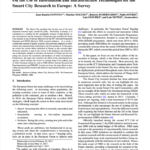
Abstract: The Smart City paradigm has become one of the most important research topics around the globe. Particularly in Europe, it is considered as a solution for the unstoppable increase of high density urban environments and the European Commission has included the Smart City research as one of the key objectives for the FP7 (Seventh Framework Program) and H2020 (Horizon 2020) research initiatives. As a result, a considerable amount of quality research, with particular emphasis on information and communication technologies, has been produced. In this paper, we review the current efforts dedicated in Europe to this research topic. Particular attention is paid in the review to the platforms and infrastructure technologies adopted to introduce the Internet of Things into the city, taking into account the constraints and harshness of urban environments. Furthermore, this paper also considers the efforts in the experimental perspective, which includes the review of existing Smart City testbeds, part of wider European initiatives such as FIRE (Future Internet Research and Experimentation) and FIWARE. Last but not least, the main efforts in providing interoperability between the different experimental facilities are also presented.
DOI / Link: https://doi.org/10.1587/transcom.2017ITI0001
Santana, J. R., Maggio, M., Di Bernardo, R., Sotres, P., Sánchez, L. & Muñoz, L.
IEICE Transactions on Communications, 101(1), 2-15.
#journal

Abstract: The smart cities vision is inexorably turning into a reality. Among the different approaches used to realize more intelligent and sustainable environments, a common denominator is the role that information and communication technologies will play. Moreover, if there is one of these technologies that emerges among the rest, it is the Internet-of-Things (IoT). The ability to ubiquitously embed sensing and actuating capabilities that this paradigm enables is at the forefront of the technologies driving the urban environments transformation. However, there are very little practical experiences of the IoT infrastructure deployment at a large scale. This paper presents practical solutions to the main challenges faced during the deployment and management of a city-scale IoT infrastructure, which encompasses thousands of sensors and other information sources. The experience we have gained during the deployment and operation of the IoT-based smart city infrastructure carried out at Santander (Spain) has led to a number of practical lessons that are summarized in this paper. Moreover, the challenges and problems examples,excerpted from our own real-life experience, are described as motivators for the adopted solutions.
DOI / Link: https://doi.org/10.1109/ACCESS.2017.2723659
Sotres, P., Santana, J. R., Sánchez, L., Lanza, J. & Muñoz, L.
IEEE Access 5 (2017): 14309-14322.
#journal

Abstract: FESTIVAL EU-Japan collaborative project aims at federating existing Smart ICT testbeds of different nature to provide a platform for developing and testing emergent Smart ICT services. The federation of testbeds covering heterogeneous domains has been a great challenge and FESTIVAL provides a uniform access to different resources, such as Open Data resources, IoT devices, IT resources and Living Labs. In this paper, design and implementation of the current FESTIVAL platform are introduced with approaches to federate and interoperate existing resources. Integration of all the components, including the existing testbeds, will also be described to finalize and validate the federation.
DOI / Link: https://doi.org/10.2197/ipsjjip.25.278
Akiyama, T., Murata, S., Tsuchiya, K., Yokoyama, T., Maggio, M., Ciulla, G., Santana, J. R., Zhao, M., Botelho Do Nascimento, J. & Gürgen, L.
Journal of Information Processing 25 (2017): 278-287.
#conference
Abstract: In parallel to the explosion of the use of wireless technologies to connect devices, the scientific community is continually aiming to take advantage of such technologies to provide new services. In this sense, there have been many attempts to exploit the information provided by IEEE802.11 and Bluetooth interfaces, commonly found in most of the smartphones that are being used at the time of writing. In this paper we describe a novel deployment that fosters such approach. Furthermore, the measurements that are gathered are made available, thanks to its integration within the SmartSantander testbed, and to the federation with complementary testbeds. The federation platform and the described deployment are outcomes of the FESTIVAL collaborative project (Europe-Japan). Besides depicting the corresponding software architecture, the paper also discusses some preliminary results that are used to assess the feasibility of the proposed scheme.
DOI / Link: https://doi.org/10.1007/978-3-319-52712-3_6
Santana, J. R., Carrasco, J., Galache, J. A., Sánchez, L. & Muñoz, L.
International Conference on Mobile Networks and Management. Springer, Cham, 2016.
#journal

Abstract: The Smart City concept is being developed from a lot of different axes encompassing multiple areas of social and technical sciences. However, something that is common to all these approaches is the central role that the capacity of sharing information has. Hence, Information and Communication Technologies (ICT) are seen as key enablers for the transformation of urban regions into Smart Cities. Two of these technologies, namely Internet of Things and Big Data, have a predominant position among them. The capacity to “sense the city” and access all this information and provide added-value services based on knowledge derived from it are critical to achieving the Smart City vision. This paper reports on the specification and implementation of a software platform enabling the management and exposure of the large amount of information that is continuously generated by the IoT deployment in the city of Santander.
DOI / Link: https://doi.org/10.4018/IJSWIS.2016100102
Lanza, J., Sotres, P., Sánchez, L., Galache, J. A., Santana, J. R., Gutiérrez, V. & Muñoz, L.
International Journal on Semantic Web and Information Systems (IJSWIS) 12.4 (2016): 22-42.
#journal
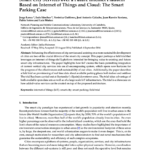
Abstract: Enhancing the effectiveness of city services and assisting on a more sustainable development of cities are two of the crucial drivers of the smart city concept. This paper portrays a field trial that leverages an internet of things (IoT) platform intended for bringing value to existing and future smart city infrastructures. The paper highlights how IoT creates the basis permitting integration of current vertical city services into an all-encompassing system, which opens new horizons for the progress of the effectiveness and sustainability of our cities. Additionally, the paper describes a field trial on provisioning of real time data about available parking places both indoor and outdoor. The trial has been carried out at Santander’s (Spain) downtown area. The trial takes advantage of both available open data sets as well as of a large-scale IoT infrastructure. The trial is a showcase on how added-value services can be created on top of the proposed architecture.
DOI / Link: https://doi.org/10.3390/en9090719
Lanza, J., Sánchez, L., Gutiérrez, V., Galache, J. A., Santana, J. R., Sotres, P. & Muñoz, L.
Energies 9.9 (2016): 719.
#book

Abstract: Smart cities are a new vision for urban development. They integrate information and communication technology infrastructures in the domains of artificial intelligence, distributed and cloud computing, and sensor networks – into a city, to facilitate quality of life for its citizens and sustainable growth. This book explores various concepts for the development of these new technologies (including agent-oriented programming, broadband infrastructures, wireless sensor networks, Internet-based networked applications, open data and open platforms), and how they can provide smart services and enablers in a range of public domains.
The most significant research, both established and emerging, is brought together to enable academics and practitioners to investigate the possibilities of smart cities, and to generate the knowledge and solutions required to develop and maintain them.
DOI / Link: https://doi.org/10.1002/9781119329954
Galache, J. A., Santana, J. R. & Muñoz, L.
Enablers for smart cities. John Wiley & Sons, 2016. Chapter 8.
#book

Abstract: FESTIVALis an H2020 EU-Japan collaborative project that aims to federate heterogeneous testbeds, making them interoperable and building an “ExperimentationasaService”(EaaS)model. Going beyond the traditional nature of experimental facilities, related to computational and networking large scale infrastructures, FESTIVAL testbeds have heterogeneous nature and in order to be federated they have been clustered in four categories: “Open Data” (i.e. open datasets), “IoT” (i.e. sensors and actuators), “IT” (i.e. computational resources) and “Living Labs” (i.e. people). Considering that every testbed category provides specific resources, the main challenge for FESTIVAL is to develop a platform that can allow experimenters to access very different assets in an homogeneous and transparent way,supporting them in the phases of the experiments. The FESTIVAL architecture, based on a multi-level federation approach, proposes a solution to this problem providing also a set of functionalities to manage and monitor the experiments. FESTIVAL tools, also, include the possibility to access FIWARE Generic Enablers allowing to deploy predefined components to address specific needs in the experimentation (e.g. data analysis, big data management etc.). The FESTIVAL platform will be tested on three different smart city domains across Japan and Europe: smart energy, smart building and smart shopping.
DOI / Link: https://doi.org/10.13052/rp-9788793519114
Maggio, M., Ciulla, G., Di Bernardo, R., Muratore, N., Santana, J. R., Akiyama, T., Gürgen, L. & Matsuoka, M.
Building the Future Internet through FIRE. River Publishers, 2017. Chapter 28.
#journal

Abstract: Smart cities are one of the key application domains for the Internet-of-Things paradigm. Extending the Web into the physical realm of a city, by means of the widespread deployment of spatially distributed Internet-addressable devices with sensing and/or actuation capabilities, allows improving efficiency of city services. Vehicles moving around the city become excellent probes when the objective is to gather information across the city in a cost effective manner. Public transportation fleets, taxis, or vehicles such as waste collection trucks cover most of the urban areas with a limited number of vehicles. This paper presents the deployment of a large scale Internet-of-Things testbed that has been carried out in the city of Santander. It extends previous descriptions by providing a specification of one of the unique features of the testbed, namely, the devices that have been installed on 140 buses, taxis, and vans that every day drive around the city. Besides the physical characteristics of the devices installed and the lessons learnt during the deployment, the paper introduces the three mobile sensing network strategies used for distributing the data gathered. Finally, the paper sketches some of smart city services which might be provided using the information coming from the mobile IoT devices.
DOI / Link: https://doi.org/10.1155%2F2015%2F785061
Lanza, J., Sánchez, L., Muñoz, L., Galache, J. A., Sotres, P., Santana, J. R. & Gutiérrez, V.
International Journal of Distributed Sensor Networks 11.8 (2015): 785061.
#conference
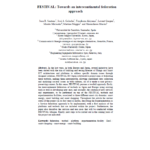
Abstract: In the last years, in both Europe and Japan, several initiatives have been started with the aim of building and testing Internet of Things and Smart ICT architectures and platforms to address specific domain issues through designed solutions. FESTIVAL EU-Japan collaborative project aims at federating these testbeds, making them interoperable, allowing centralized data collection and analyzing societal issues in both cultures, all of it under a user privacy-preserving context. In this sense, FESTIVAL pursues a twofold approach: firstly, the intercontinental federation of testbeds in Japan and Europe using existing tools as well as developing new ones; and secondly, the creation of new services and experiments, to be performed on top of the FESTIVAL testbeds and experimentation facilities, associated to three different smart city domains: smart energy, smart building and smart shopping. Throughout this article the current status of the project (in its first year) is shown, describing the Experimentation as a Service federation approach to be implemented, with a first analysis of the platforms and testbeds that are included within the project. Furthermore, the paper also describes the services and use cases that will be conducted within FESTIVAL lifespan. Finally, next steps to be carried out in the coming years of the project are indicated.
DOI / Link: https://doi.org/10.1007/978-3-319-26925-2_20
Santana, J. R., Galache, J. A., Akiyama, T., Gürgen, L., Matsuoka, M., Maggio, M. & Murata, S.
International Conference on Mobile Networks and Management. Springer, Cham, 2015.
#letter
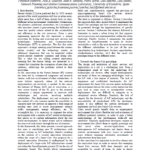
Abstract: Recent studies [1] have predicted that by 2050 seventy percent of the world population will live in urban areas,while more than a half of them already lives in cities. Different urban-environment stakeholders (technicians,
city planners, politicians, researchers, etc.) are urged to take measures aimed at guaranteeing the fulfilment of some key quality criteria related to the sustainability and efficiency in the city processes. From a pure engineering approach the city represents a unique ecosystem for testing and assessing new services and technologies, Information and Communications Technologies (ICT) in particular. The fact that cities represent a strategic meeting point between the citizens (urban society) and the technology creates an additional dimension that can be exploited within crowd-sourced creativity scenarios and living labs. This is what we are calling societal innovation,meaning that the human beings are immersed in a context that stimulates the conception of new ideas and solutions, addressing the problems related to their ecosystem.
DOI / Link: https://pdfs.semanticscholar.org/5b96/dbd352b753b9adf8206a5cd29c86e4fe023b.pdf#page=35
Guitérrez, V., Galache, J. A., Santana, J. R., Sotres, P., Sánchez, L. & Muñoz, L.
IEEE COMSOC MMTC E-Letter. Vol.9, No.5, September 2014.
#journal
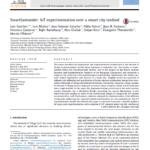
Abstract: This paper describes the deployment and experimentation architecture of the Internet of Things experimentation facility being deployed at Santander city. The facility is implemented within the SmartSantander project, one of the projects of the Future Internet Research and Experimentation initiative of the European Commission and represents a unique in the world city-scale experimental research facility. Additionally, this facility supports typical applications and services of a smart city. Tangible results are expected to influence the definition and specification of Future Internet architecture design from viewpoints of Internet of Things and Internet of Services. The facility comprises a large number of Internet of Things devices deployed in several urban scenarios which will be federated into a single testbed. In this paper the deployment being carried out at the main location,namely Santander city, is described. Besides presenting the current deployment, in this article the main insights in terms of the architectural design of a large-scale IoT testbed are presented as well. Furthermore, solutions adopted for implementation of the different components addressing the required testbed functionalities are also sketched out. The IoT experimentation facility described in this paper is conceived to provide a suitable platform for large scale experimentation and evaluation of IoT concepts under real-life conditions.
DOI / Link: https://doi.org/10.1016/j.bjp.2013.12.020
Sánchez, L., Muñoz, L., Galache, J. A., Sotres, P., Santana, J. R., Gutiérrez, V., Ramdhany, R., Gluhak, A., Krco, S., Theodoridis, E. & Pfisterer, D.
Computer Networks 61 (2014): 217-238.
#journal
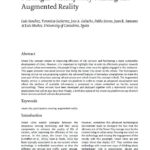
Abstract: Smart City concept relates to improving efficiency of city services and facilitating a more sustainable development of cities. However, it is important to highlight that in order to effectively progress towards such smart urban environments, the people living in these cities must be tightly engaged in this endeavor. This paper presents two novel services that bring the Smart City closer to the citizen. The Participatory Sensing service we are proposing exploits the advanced features of nowadays smartphones to make the user part of the ubiquitous sensing infrastructure over which Smart City concept is built. The Augmented Reality service is connected to the smart city platform in order to create an advanced visualization tool where the plethora of available information is presented to citizen embedded on her/his natural surroundings. These services have been developed and deployed together with a real-world smart city deployment that will be also described. Finally, a brief description of the smart city platform on top of which these services are built will also be presented.
DOI / Link: N/A
Sánchez, L., Gutiérrez, V., Galache, J. A., Sotres, P., Santana, J. R. & Muñoz, L.
Interdisciplinary Studies Journal, 2014, 3(4) 129-142
#conference

Abstract: This paper describes the deployment and high-level architecture of the Internet of Things experimentation facility being deployed at Santander city. SmartSantander is a unique in the world city-scale experimental research facility in support of typical applications and services for a smart city. The testbed that has been deployed has a dual purpose. On the one hand it will allow real-world experimentation on Internet-of-Things related technologies (protocols, middlewares, applications, etc.). On the other hand it is currently supporting the provision of smart city services aimed at enhancing the quality of life in the city of Santander. Tangible results are expected to greatly influence definition and specification of Future Internet architecture design from viewpoints of Internet of Things and Internet of Services. This paper presents the physical deployment carried out in the city of Santander and the high-level architecture supporting the experimentation and service provision duality. Moreover, a brief description of the mechanisms supporting the experimentation life cycle will be done. Finally, the services that are being provided to the city will also be sketched.
DOI / Link: https://ieeexplore.ieee.org/document/6618633/
Sánchez, L., Gutiérrez, V., Galache, J. A., Sotres, P., Santana, J. R., Casanueva, J., & Muñoz, L.
16th International Symposium on Wireless Personal Multimedia Communications (WPMC 2013)
#conference

Abstract: The Future Internet Research and Experimentation (FIRE) initiative aims at achieving experimentation and testing in large-scale environments, through the creation of a multidisciplinary research environment for investigating and experimentally validating highly innovative and revolutionary ideas for new networking and service paradigms. SmartSantander FP7 project aims at the creation of an experimental test facility for the research and experimentation of architectures, key enabling technologies, services and applications for the Internet of Things (IoT) in the context of a city. In this sense, this paper presents the deployed facility, emphasizing the capacity of experimenting over this large-scale test bed, through the reprograming of the deployed IoT devices with different code images. For this purpose, the implementation and validation of an Over the Air programming (OTAP) scheme has been carried out, coexisting with the service provision and experimentation ability simultaneously offered over the deployed facility.
DOI / Link: https://doi.org/10.1109/WAINA.2013.166
Galache, J. A., Sotres, P., Santana, J. R., Gutiérrez, V., Sánchez, L. & Muñoz, L.
27th International Conference on Advanced Information Networking and Applications Workshops (WAINA 2013)
#conference
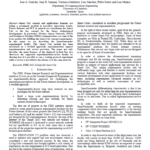
Abstract: Smart City concept and applications domains are taking a prominent position in nowadays innovation trends. Future Internet and ICT in general are considering the Smart City as the key concept for the future technological developments. In particular, Wireless Sensor Networks (WSN) and Machine to Machine (M2M) communications are some of the basic enablers for fulfilling the Smart City concept requirements. In this paper we are describing the SmartSantander experimental facility. This Smart City testbed has been envisioned on a twofold approach: experimentation support experimentation and service provision. The paper not only describes the main features of the deployed testbed but also showcases the supported experimentation-service duality by showing how it is possible to run a routing protocol experiment while a service is provided to the citizens over the same network.
DOI / Link: https://doi.org/10.1109/WONS.2012.6152226
Galache, J. A., Santana, J. R., Gutiérrez, V., Sánchez, L., Sotres, P. & Muñoz, L.
9th Annual Conference on Wireless On-Demand Network Systems and Services (WONS 2012)
#conference
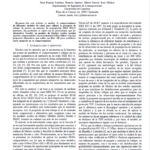
Abstract: El paradigma de la Internet de las Cosas (Internet of Things, IoT), está deparando nuevos retos a la comunidad científica que deben ser tratados para conocer su impacto en el rendimiento de las redes existentes y de las futuras. En este artículo, se presenta una novedosa propuesta que concilia tanto la investigación experimental dentro de un despliegue masivo, como la provisión de servicio minimizando el impacto de ambos planos, esto es experimentación y provisión de servicio. En este sentido, se han definido algunos casos de uso para ser implementados sobre la arquitectura desplegada, centrándose este artículo en el de la gestión inteligente del aparcamiento. El despliegue llevado a cabo ha sido desarrollado bajo el paraguas del proyecto europeo SmartSantander, como un primer piloto.
DOI / Link: N/A
Galache, J. A., Gutiérrez, V., Sánchez, L., Santana, J. R., Muñoz, L., Gascón, L., Hernández, J. M., Sarmiento, B. & González, L.
XXI Jornadas TELECOM I+D (TELECOM I+D 2011)
#conference

Abstract: En este trabajo se analiza el comportamiento de diferentes modelos de canal para reflejar la presencia de ráfagas de errores en entornos de propagación IEEE 802.11 interiores. En particular se centra en las prestaciones que las alternativas basadas en modelos de Markov ocultos pueden aportar, comparándolos con el tradicional Gilber-Elliot y con una propuesta alternativa, que utiliza un filtro AR para establecer cierta memoria en su comportamiento.
DOI / Link: http://jitel2010.tel.uva.es/programa.html (Paper not available, only the event agenda)
Santana, J. R., Agüero, R., García, M. & Muñoz, L.
IX Jornadas de Ingeniería Telemática (JITEL 2010)
